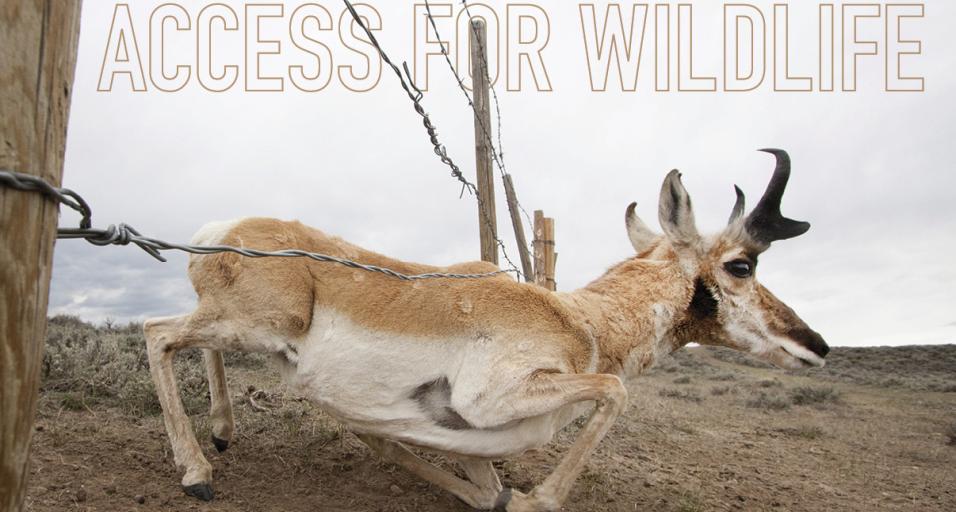As one traverses Wyoming's vast, open spaces, it’s possible to drive hours without seeing any development on the landscape. Some infrastructure in these open spaces is so ubiquitous that it's nearly invisible. It’s simple to look over or through fencing without recognizing it as a barrier to people and wildlife. Though the impacts of fences on wildlife are woefully understudied, recent studies have indicated fences can have a significant impact. Wildlife managers, landowners, conservation organizations and federal land management agencies work together to minimize those impacts.
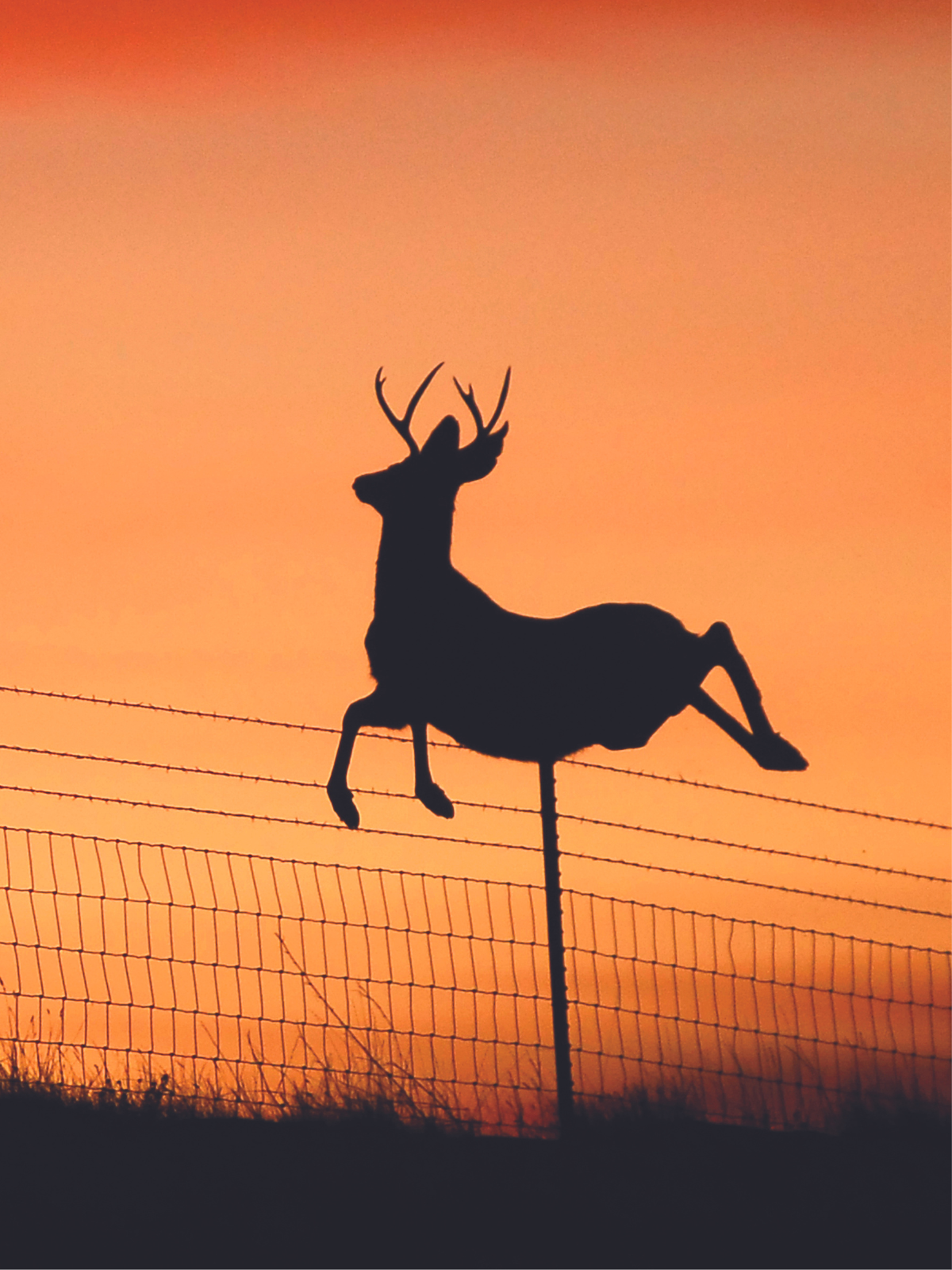
RESTRICTING MOVEMENTS
Fences are helpful tools that can delineate land ownership or manage domestic livestock. Fences work well for those uses, but analyzing their adverse effects on wildlife is challenging. The few studies that have been conducted confirmed that, at a minimum, fences can negatively impact wildlife movement and, at their worst, are deadly to wildlife. Professionals and college students are working together to learn more about the extent of the impacts of fences on wildlife movements.
One study completed by researchers at Utah State University in 2005-06 involved routinely driving and walking fence lines and documenting deer, pronghorn and elk mortalities. Results indicated that each year, one ungulate died from fence entanglement for every 2.5 miles of fence in the study area. Death rates were higher for young animals found stranded on the opposite side of the fence from their mothers — a death for every 1.2 miles of fence. Fences were especially deadly to juvenile animals, and higher mortalities were noted in the month of August after fawns were weaned.
Some fences on private property and maintained by livestock managers are unmapped, so there isn’t an inclusive dataset detailing where fences are in the state, let alone the style and specifications of those fences.
"We know fences are necessary on our landscape, but we can rebuild fences to manage livestock and have less impact on wildlife,” said Jill Randall, Wyoming Game and Fish Department statewide migration coordinator. “We are working with many partners to map the locations and condition of fences to help prioritize where to focus our time and funding resources to maximize the benefit to critical wildlife habitats such as winter range and migration routes. We’re also using GPS collar data from big game to identify areas where animals struggle to navigate the fence so we can prioritize converting those fences to wildlife-friendly standards.”
Collaborative work is ongoing between the Natural Resources Conservation Service and university researchers to develop applications for more efficiently mapping fences. We know the impacts on wildlife need to be studied further to determine the total impact and work diligently to mitigate those unintended consequences of fencing on our wild populations.
Wildlife managers in Wyoming have partnered with researchers at the University of Wyoming to learn more about different fence styles and their permeability to wildlife. Another effort is underway to evaluate how wildlife responds to fences, including fences modified to reduce their impact on wildlife movements. Game and Fish personnel also are working with UW researchers to develop applications for more efficiently mapping fences in important wildlife habitats and highlighting the highest priority fences based on wildlife in the area. Results from these studies will continue to inform the best practices for fence installations and modifications.
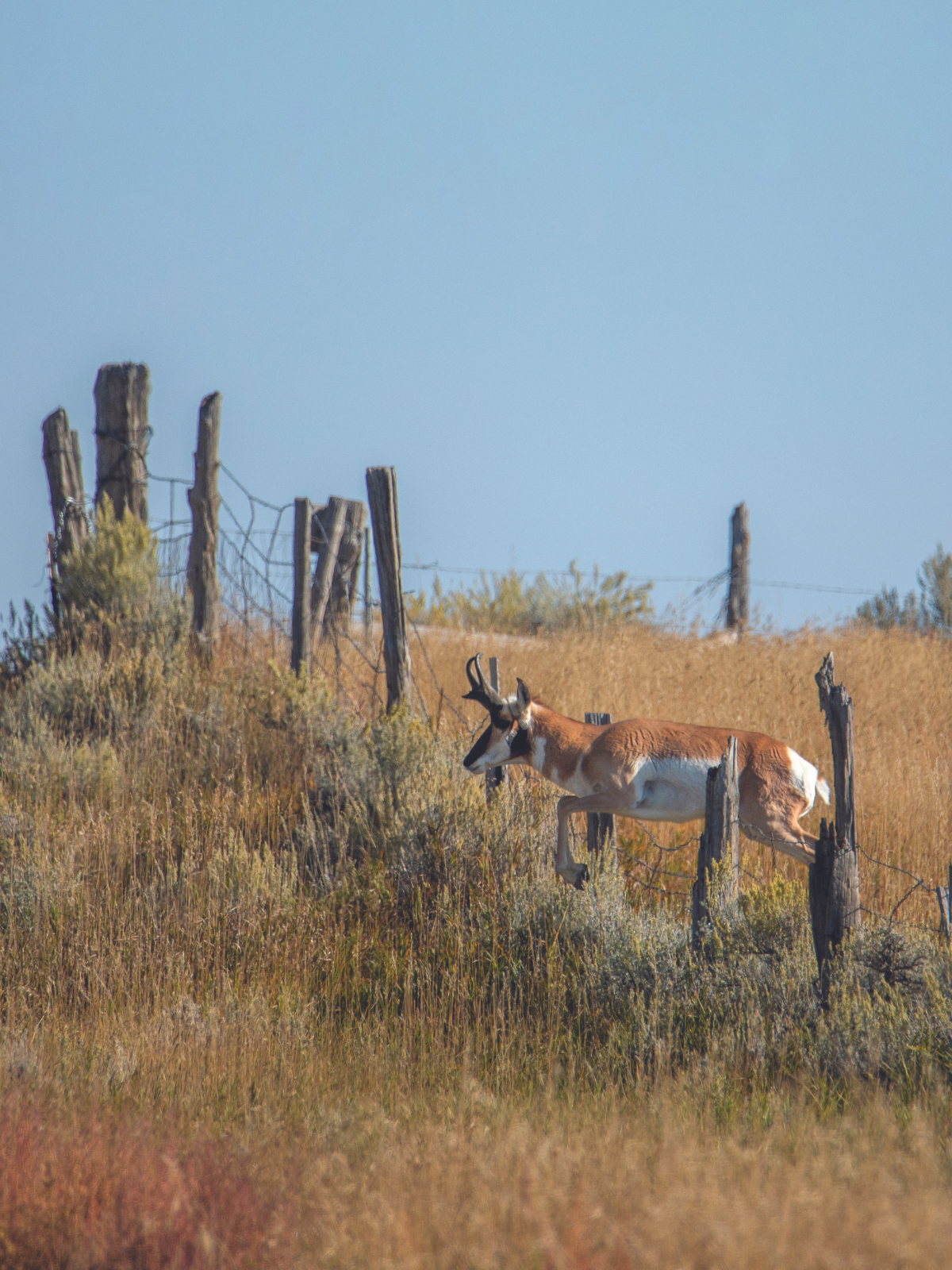
GOOD NEIGHBORS
We’ve all heard that “good fences make good neighbors.” That saying couldn’t ring more accurately than with fences and wildlife. A good fence achieves its purpose of delineating property or separating livestock, but some styles of fencing that are effective at containing livestock have unintended, negative consequences.
Wyoming is a “fence-out state,” meaning it is the responsibility of landowners to protect their property from free-ranging livestock. Landowners must keep unwanted cattle, horses and domestic bison out of their properties rather than stock owners containing them in a specific area. Legally, stock owners of these types of livestock are not liable for trespass or damage if a lawful fence does not adequately protect a property. The opposite is true when it comes to sheep. Sheep owners are responsible for keeping their sheep where they are supposed to be — so fences for sheep are designed to keep them within a designated area.
One of the most effective fence types for containing livestock also is the most troublesome for wildlife. Woven-wire fences can contain livestock and stand up to deep snow and wind. We now know that these sturdy fences are also a significant obstacle for young wildlife who cannot jump over them and are too large to pass through. Although adults may be able to jump this style of fence, their fawns and calves may not be able to navigate to the other side; this can result in the separation of young wildlife from their mothers and the potential for death from exposure and dehydration. These fences pose a considerable challenge to pronghorn, which prefer to pass under fence wires even as adults.
Woven-wire fences also impede the movement of larger animals, including black bears. If they are topped with a single strand of barbed wire, they become more lethal to wildlife. The woven wire means animals must go over the fence to cross it, and a wire at the top increases the chances of snaring a leg and trapping the animal, which can lead to unnecessary suffering, injury and sometimes death. The risk of death or injury is exceptionally high with fences that are 38 inches or taller. The impacts of fences are not isolated to deer, elk and pronghorn. Birds also can be victims. Fences that run near or across waterways can impede large, low-flying birds such as sage grouse, swans, cranes, ducks, geese, owls and hawks.
The best fence for wildlife is no fence at all. When replacing, repairing or installing fences, considerations can be made to accomplish the fence's intended purpose while minimizing the impacts on wildlife. When a fence has outlived its use, it should be removed. If a fence is necessary, consider its intended purpose — whether that be property delineation, deterrence of trespassers or containment of livestock. If the fence is for livestock, consider the times of year it is needed. Resources are available to assist landowners with planning for fences that serve their intended purpose and minimize the negative impacts on wildlife.
WILDLIFE-FRIENDLY FENCE
Many styles of fencing can be adjusted to wildlife-friendly options that meet the varied needs of landowners. Typically, a wildlife-friendly fence should be low enough for ungulates to jump — preferably 38 or 40 inches or less with a maximum height of 42 inches. The top two wires of a fence should be at a minimum of 10 inches apart with the preference of 12 inches apart or more. This helps prevent an animal’s back foot from getting caught during a leap. The bottom wire should be high enough for animals like pronghorn or fawns who prefer to crawl underneath the fence. The bottom wire should be a minimum of 16 inches from the ground, but 18 inches is preferred. In addition, the top wire should be clearly visible to wildlife.
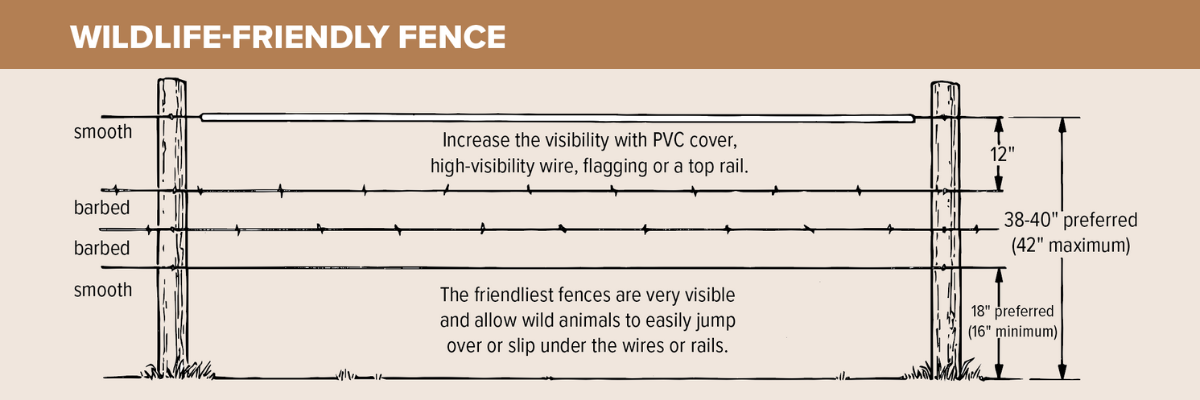
These recommendations can be tailored to suit specific needs and terrain. Landowners can make adjustments based on their own needs while ensuring the best outcomes for both their land and wildlife.
YOU CAN MAKE A DIFFERENCE
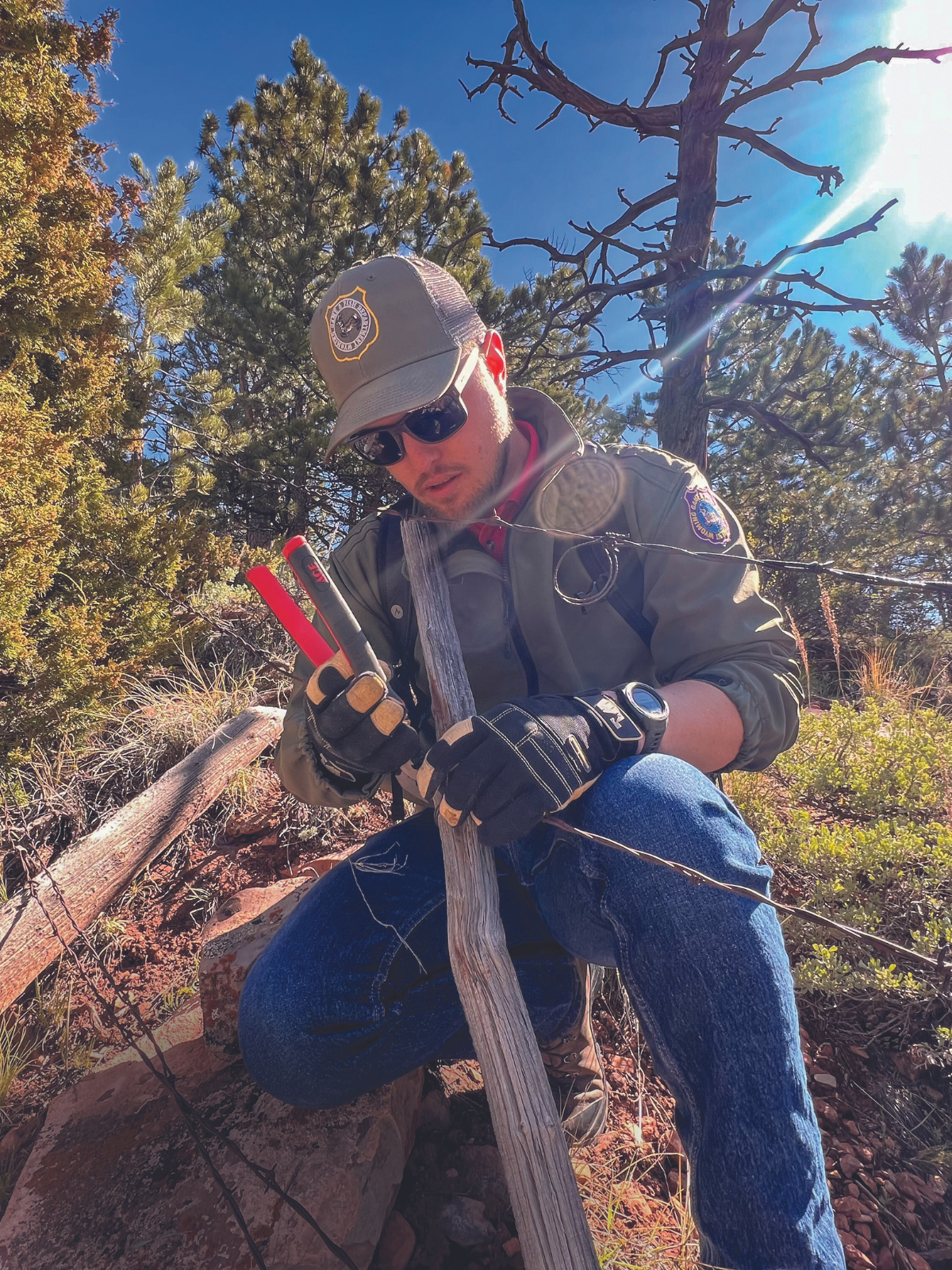
Landowners and land managers can make a difference for wildlife moving across the landscape. Here are a few tips to facilitate big game movements on your property.
- Leave gates open when livestock are not in the adjacent pasture, particularly during winter months.
- Modify your fences to more permeable specifications or install additional gates or crossing structures that can be left open seasonally.
- Prioritize removal or conversion of woven wire fences if a standard 3- or 4-wire fence will meet the livestock containment needs.
- Volunteer with a local conservation or sportsperson group that is working on fence removal or modification projects.
- Support adjacent landowners and agencies when they would like to use wildlife-friendly specifications while reconstructing fences adjacent to your property, including highway rights-of-way.
COLLABORATIVE EFFORTS
Several initiatives have been spawned across Wyoming in response to some of these fence studies. These initiatives focus on wildlife conservation while continuing to foster multiple land uses. These are collaborative groups of local stakeholders, including landowners, managers, producers, sportspersons, conservationists, community members, regional leaders, government agencies, foundations, granters and outdoor enthusiasts working to identify problem fences and replace them with wildlife-friendly alternatives.
“Our local fence initiative leverages each partner's unique resources and abilities to improve problematic fencing for wildlife,” said Troy Fieseler, Game and Fish terrestrial habitat biologist in the Pinedale Region. “This ranges from local knowledge and expertise to grant writing and fundraising to providing field staff and labor to implement projects on the ground.”
One of these initiatives is The Upper Green Fence Initiative. This cooperative effort between Game and Fish, Sublette County Conservation District and the Natural Resources Conservation Service, along with other federal agencies and nongovernmental organizations, has modified or removed more than 700 miles of fencing in Sublette County since 2012.
“Landowner participation has been the cornerstone of the growth and success of the program,” Fieseler said. “We wouldn’t be where we are today without them.”
The fencing conversions in this area will facilitate wildlife movements in crucial migratory habitats for the Wyoming Range mule deer, Sublette mule deer and Sublette pronghorn herds. These herds suffered significant losses during the winter of 2022-23 due to severe weather and pneumonia outbreaks.
Currently, abundant funding resources are available to those seeking to modify existing fences to more wildlife-friendly options. The Natural Resources Conservation Service can help cover the costs for landowners through the Migratory Big Game Initiative, provided the modified fence meets wildlife-friendly specifications. The Game and Fish Movement Matters Team has established a goal of implementing 100 percent wildlife-friendly fencing on department-managed lands, where appropriate, by 2033. Fence modification and removal continue to be a priority for the Game and Fish to maximize habitat connectivity and wildlife movement.
— Regina Dickson is the Wyoming Game and Fish Department's information and education specialist in the Green River Region.
View "A Landowner's Guide to Fencing and Wildlife" and find more information about resources for wildlife-friendly fencing on the Game and Fish website. Landowners seeking additional resources for these kinds of fencing projects are also encouraged to contact their local Game and Fish, National Resources Conservation Services or Conservation District offices.

